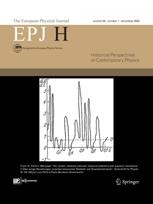A question of reality
John Stewart Bell’s eponymous theorem and inequalities set out, mathematically, the contrast between quantum mechanical theories and local realism. They are used in quantum information, which has evolving applications in security, cryptography and quantum computing.
New York | Heidelberg, 24 September 2020
 The distinguished quantum physicist John Stewart Bell (1928-1990) is best known for the eponymous theorem that proved current understanding of quantum mechanics to be incompatible with local hidden variable theories. Thirty years after his death, his long-standing collaborator Reinhold Bertlmann of the University of Vienna, Austria, has reviewed his thinking in a paper for EPJ H, ‘Real or Not Real: That is the question’. In this historical and personal account, Bertlmann aims to introduce his readers to Bell’s concepts of reality and contrast them with some of his own ideas of virtuality.
The distinguished quantum physicist John Stewart Bell (1928-1990) is best known for the eponymous theorem that proved current understanding of quantum mechanics to be incompatible with local hidden variable theories. Thirty years after his death, his long-standing collaborator Reinhold Bertlmann of the University of Vienna, Austria, has reviewed his thinking in a paper for EPJ H, ‘Real or Not Real: That is the question’. In this historical and personal account, Bertlmann aims to introduce his readers to Bell’s concepts of reality and contrast them with some of his own ideas of virtuality.
Bell spent most of his working life at CERN in Geneva, Switzerland, and Bertlmann first met him when he took up a short-term fellowship there in 1978. Bell had first presented his theorem in a seminal paper published in 1964, but this was largely neglected until the 1980s and the introduction of quantum information.
Bertlmann discusses the concept of Bell inequalities, which arise through thought experiments in which a pair of spin-½ particles propagate in opposite directions and are measured by independent observers, Alice and Bob. The Bell inequality distinguishes between local realism – the ‘common sense’ view in which Alice’s observations do not depend on Bob’s, and vice versa – and quantum mechanics, or, specifically, quantum entanglement. Two quantum particles, such as those in the Alice-Bob situation, are entangled when the state measured by one observer instantaneously influences that of the other. This theory is the basis of quantum information.
And quantum information is no longer just an abstruse theory. It is finding applications in fields as diverse as security protocols, cryptography and quantum computing. “Bell’s scientific legacy can be seen in these, as well as in his contributions to quantum field theory,” concludes Bertlmann. “And he will also be remembered for his critical thought, honesty, modesty and support for the underprivileged.”
References: R. Bertlmann (2020), Real or Not Real: that is the question, European Physical Journal H, DOI 10.1140/epjh/e2019-90071-6
Further Information
For more information visit: www.epj.org
Services for Journalists
The full-text article is available here.
Contact
Sabine Lehr | Springer | Physics Editorial Department
tel +49-6221-487-8336 | sabine.lehr@springer.com
